Diyarbakir Bar Association, Mayor's Office and Gomidas Institute Commemorate Armenian and Assyrian Genocide (23 April 2013)
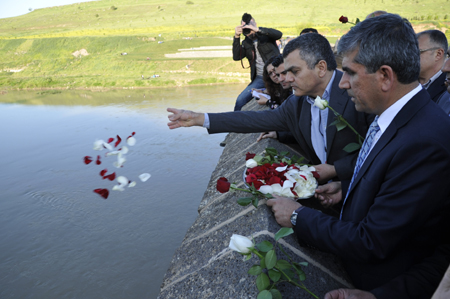 28 April 2013
28 April 2013

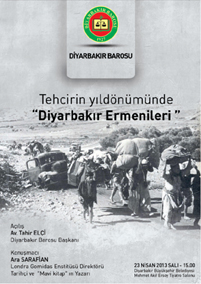
TALK DELIVERED BY ARA SARAFIAN AT CONFERENCE ORGANISED BY
THE DIYARBEKIR BAR ASSOCIATION AND THE MAYORS OFFICE
IN DIYARBEKIR TOWN HALL (BELEDIYE) ON 23 APRIL 2013
A Personal Statement (Appended to Original Notes on 23 April 2013)
I came to Diyarbekir two days ago. I wanted to investigate a specific massacre of 600 Armenians that took place in June 1915. I went to the area in question and told local Kurds why I was there. They told me what they knew.
Everyone I spoke with welcomed me as a native of this land. They knew about the Armenian Genocide and some of their ancestors had participated in such killings. Some had Armenians, mainly women and children, assimilated into their families as a result of the events of 1915. There was real sadness in their voice.
We found the place I was looking for. It was several kilometers away. I was also able to corroborate my information about that massacre from a man whose grandfather had been there. It was a moving experience. We all identified with the victims and shared a common grief.
Later, elsewhere, a man asked me if I felt any hostility towards him and his friends, knowing that their ancestors had massacred Armenians. I did not know how to answer him. The thought had not entered my mind.
In my experience, in places like Van, Diyarbekir and Elazig, I have only felt warmth in Kurdish regions of Turkey, and I have always been accepted as a native of this land. Kurds understand the sense of suffering and injustice that so many Armenians feel today. After all, Kurds have also suffered similar injustices - massacre, humiliation, denial of personal and historical identity. Perhaps it is for this reason that Diyarbekir has taken the lead in showing the rest of Turkey how to deal with the legacy of 1915.
I hope that more towns and villages will choose to take a position on the events of 1915, to state the truth, and to make their peace with Armenians. Today’s events in Diyarbekir, such as this talk at the Diyarbekir Bar Association, or the formal ceremony remembering the genocide of Armenians and Assyrians in 1915 in the presence of the Mayor of Diyarbekir, are important steps in the right direction.
SPEAKER’S NOTES ON MAIN TALK (not all illustrations reproduced here)
Armenians in the Ottoman Empire and Diyarbekir
1. Armenians were one of the major communities living in the Ottoman Empire. By 1914 they numbered around 2 million people. Most Armenians were members of the Armenian Apostolic or Gregorian church, but many were members of the Armenian Catholic, and Protestant Communities. They shared a common language and had their own communal institutions, schools, churches, and press. [Population Map, Schools Map, Churches Map]

2. Around 80,000 Armenians lived in Diyarbekir vilayet, which was predominantly Kurdish. There were also sizeable Assyrian and Chaldean communities in the province. Armenians lived mainly in the north of the vilayet, with a major concentration in the city of Diyarbekir. They were successful merchants, artisans and industrialists. [Map of Vilayet with Christian populations]
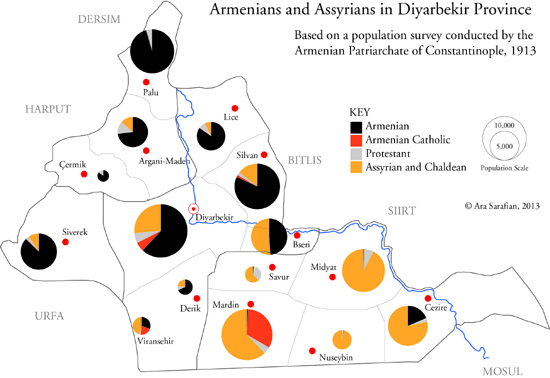
Armenian Genocide and Diyarbekir
3. In 1915, practically all Armenian communities in the Ottoman Empire were targeted for destruction. The ideological context for this genocide was to Islamicise and Turkify the Empire. Armenian communities were destroyed according to a common pattern, which was particularly violent in the eastern provinces, including Diyarbekir. The key elements of this process were to:
a. Disarm and murder Armenian conscripts in the Ottoman army by working them to death in labour battalions (amele taburlari) or massacring them outright.
b. Vilify Armenian communities to isolate them in the eyes of their mainly Muslim neighbours and to justify the so-called "deportations”, even killings.
c. Arrest and murder Armenian community leaders.
d. Remove the remaining population in a so-called deportation and resettlement programme calculated to kill deportees through privations and outright massacres.
e. Assimilate women and children in Muslim households.
4. The chief architect of the Armenian Genocide in the Diarbekir provınce was the governor Dr. Mehmed Reshid, a member of the CUP, who was appointed to his office in March 1915. Reshid had local allies on his side as well as a militia under the control of his henchmen. This militia was called kassab taburlari by Armenians of the city. One of his main supports was Mektubji Bedreddin Bey, who was later appointed the mutesarrif of Mardin, and organised similar killings there.
Most Armenian community leaders in Diyarbekir were arrested in April, including the clergy. The main killings started with the despatch of a group of 635 men, who were put on keleks, supposedly to go to Mosul at the end of May 1915. These men were sent off under guard. When they reached Shefka on the Tigris, they were taken off and killed. The Armenian Prelate of Diyarbekir, Mugrdich Chlghadian, was tortured and killed in Diyarbekir prison.
The remaining Armenian population, as well as a large number of Assyrians, were sent away in convoys starting in July 1915. Some were killed in the outskirts of the city, others further away, at such locations as Ras-ul-Ain and Der Zor. The Armenian Catholic Prelate, Bishop Andreas Chelebian , and the head of the Protestants, Rev. Hagop Andonian, were both killed in separate caravans that left the city. Only around 1,200 Armenians remained in the city. These were mostly artisans whose skills were still needed. Some Armenians also survived by being allowed to convert to Islam, while others, mainly women and children, survived by assimilating into Muslim households.
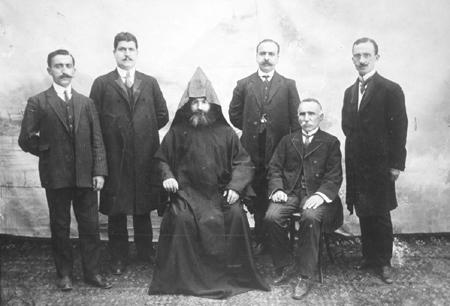
If one look at the fate of Armenian clergymen as a control group, one can see that well over 90% were killed during 1915-18. In the case of Diyarbekir province, of 122 named Armenian clergymen 115 were reportedly killed in the Genocide and two died of natural causes. [Show data] Similarly, Minister of Interior Talaat Pasha’s own report on Armenians, based on a survey he ordered in 1917, of 1.6 million Ottoman Armenians (according to official figures for 1914), 1.2 million were missing in 1917, and a further 200,000 survived outside of their native provinces. In the case of Diyarbekir province, of 56,166 Armenians in the province (according to official figures for 1914 – unadjusted figures), practically none remained in Diyarbekir in 1917, while 1,849 were counted in other provinces. The main concentrations were Aleppo 796, Syria 598, Beyrout 177 and Adana 144. That means that, in Talaat’s view, 97% of Armenians in Diyarbekir province had disappeared by the middle of 1917. [Map Illustrating Talaat’s Data]
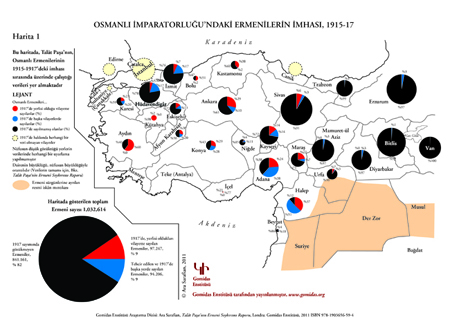
Full report with a discussion of data see http://www.gomidas.org/books/show/23
or http://www.gomidas.org/books/show/71
Final Remarks
This week commemorates the 98th anniversary of the Armenian Genocide. While it is disappointing to see the Turkish state continue in its denial of the genocide against Armenians and Assyrians in 1915, it is encouraging to see more and more Turkish citizens speaking up for the truth, claiming the moral high ground, and calling for the official Turkish recognition of the Armenian Genocide. Only with such recognition can there be healing of wounds and true reconciliation. I wish to thank the Diyarbekir Bar Association for allowing me to speak here. I hope such contacts will lead to meaningful dialogue and concrete steps in undoing some of the mistakes of the past.
* * * * *
TEXT READ BY ARA SARAFIAN AT ARMENIAN GENOCIDE COMMEMORATION ON THE OLD SARACENS' BRIDGE OUTSIDE DIYARBAKIR (23 APRIL 2013)
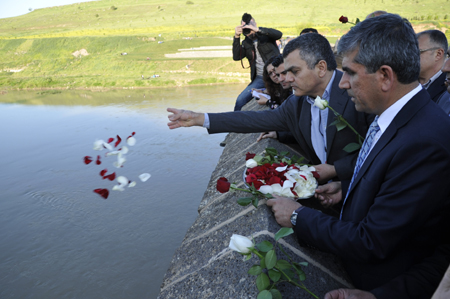
"Blessed are the Peacemakers"
The river Tigris has seen the development of many cultures and civilisations over thousands of years, from Assyrians and Babylonians to Armenians, Kurds and Arabs. For much of history, people of different faiths, languages and ethnicities have lived alongside each other in peace and harmony. However, the Tigris has also seen some of the worst slaughters man has devised against man.
We are gathered here to remember such killing that took place on this river and beyond 98 years ago. This was the genocide committed against Armenians and Assyrians in 1915. Within a matter of a few years, thousands of people were killed, their schools and churches closed down, and their collective existence brought to an end. My ancestors survived this carnage and fled abroad.
I am one of the descendants of such survivors outside of Turkey. But my presence here is not just symbolic. I am not looking for closure but a new opening. And I believe we are at the beginning of such a process whose success depends on how we behave today.
Over the past decade, a number of local politicians in Diyarbekir, such as the city’s Mayor Osman Baydemir, have taken the initiative to reverse the legacy of 1915. They have symbolically rebuilt and reopened of Surp Giragos church, they have allowed the teaching and use of Armenian in the city, and they have recognised that Armenians and Assyrians are part of the very fabric of these lands.
Today’s commemoration of the Armenian Genocide and the Seyfo are important step in this process of reconciliation. It is part of a real process, a declaration of contrition, and the wish to make amends for past wrongs. It is a declaration of peace to lighten the hearts of victims and to allow healing to take place. It is a declaration of love. It represents the best this land has to offer to the world.
"Blessed are the peacemakers” says the Bible. May this process continue, and may all the children of this land – Kurds and Armenians, Turks and Assyrians, Arabs and Yezidis, Muslims and Christians live together without fear, in peace, and in harmony.
[Turkish translation]
Barış yapıcıları Yaradan’ın mübarek kullarıdır
Dicle nehri binlerce yıldır, Süryanilerden Babillilere, Ermenilerden Kürtlere ve Araplara, çok çeşitli kültürlerin ve uygarlıkların gelişimine tanıklık etmiştir. Tarihinin çok büyük bir bölümünde farklı inanç, dil ve etnik kimliklerden halklar yan yana barış ve uyum içinde var olmuşlardır. Ancak Dicle, insanın insana yaptığı en korkunç katliamların da tanığıdır.
Bizler burada, bundan 98 yıl önce Dicle kıyısında ve nehrin uzandığı diğer yerlerde bu katliamları hatırlamak için bir araya geldik. Bu, Ermenilere ve Süryanilere yapılan bir soykırımdı. Birkaç yıl içinde binlerce insan katledildi, okulları, kiliseleri kapatıldı ve kolektif varoluşlarına son verildi. Benim atalarım bu kıyımdan kurtulup yurt dışına kaçmayı başardılar.
Ben, tıpkı benim gibi Türkiye dışında yaşayan soykırım kurtulanlarının torunlarından bir kısmını temsilen burada aranızda bulunuyorum. Ama burada bulunuşum yalnızca simgesel bir anlam taşımıyor. Ben bir şeyleri kapatmanın değil, yeni bir açılımın arayışı içindeyim. Böyle bir sürecin başlangıcında olduğumuza inanıyorum. Sürecin başarısı nasıl davrandığımıza, ne yaptığımıza bağlı olacaktır.
Son 10 yıl içinde Diyarbekir’de yerel siyasetçiler 1915’in mirasını tersine çevirecek bir girişim başlattılar. Simgesel bir adım olarak Surp Giragos kilisesini restore ettiler ve yeniden açtılar, kentte Ermenicenin öğretimini ve kullanımına olanak tanıdılar ve Ermenilerin, Süryanilerin bu toprağın bir parçası olduğu gerçeğini dile getirdiler.
Bugün Ermeni Soykırım ve Süryanilerin soykırımı "Seyfo”nun anılması barışma sürecinde önemli bir adımdır. Gerçek bir sürecin, yani, bir nedamet ilanının ve geçmişteki haksızlıkların telafi edilmesi arzusunun bir parçasıdır. Kurbanların acılarını hafifletmeyi ve yaralarını iyileştirmeyi hedefleyen bir barış ilanıdır. Sevginin ilanıdır ve bu toprakların dünyaya sunabileceği en güzel armağanı temsil eder.
İncil, "barış yapıcıları Yaradan’ın mübarek kullarıdır” der. Biz diyoruz ki, bu süreç devam etsin, bu toprakların çocukları, Kürtler ve Ermeniler, Türkler ve Süryaniler, Araplar ve Yezidiler, Müslümanlar ve Hristiyanlar korkusuzca, barış ve uyum içinde yaşasın.